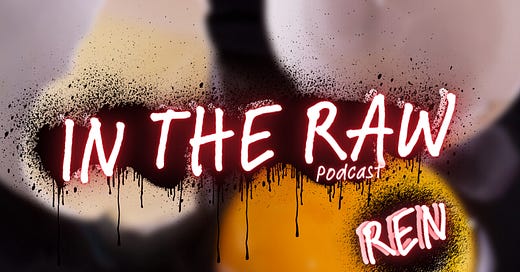Welcome back to IN THE RAW, my podcast. This week I’m speaking to another artist, Bobby Mars, about his photographic art; his writing, including the essay “Facedox Hermeticism,” which I wrote a response to on my Stack; and an exclusive essay on AI e-girls, which he calls “the next phase in the gender war.
The new essay is directly below a selection of Bobby’s photographic art. See his website for more.
“AI e-girls: The next phase in the gender war”
by Bobby Mars
Take a look at the young lady above. Pretty, isn’t she? Wouldn’t you like to know her?
Would it surprise you to hear that she’s not real, that in fact I used generative AI to produce her source image? I filtered it through some clever tricks, of course, photographing the image itself on film off of an old cathode-ray-tube television. Ironically, the more mediated, the more noisy the image, the more realistic it seems.
Yes, I’ve joined the ranks of men making fake images of pretty girls with generative AI. In my case, I hope, for sophisticated conceptual reasons—I wanted to prove a point about the dubious veracity of images in general. No gooning allowed to my e-girl! Yet, many creators are employing AI image generators for more worldly purposes. Entire personas, complete with social media profiles, videos, even OnlyFans accounts have been produced with such tools. Digital pimps don’t even need real hoes anymore. Men will rack up those view counts, even pay for content if it’s good enough.
Clearly this is the fall of civilization. Big tech taking jobs from hardworking women yet again. This is the future the woke left wants for us! Men will abandon real women altogether soon, once Silicon Valley perfects their robot sex bots and integrates them with AI. The end is nigh.
Apocalyptic hyperbole, I tell you. Don’t be alarmed. Neither gender will be replaced. Men have already had a seeming replacement for women for centuries—their own hands. Women’s sex toys grow increasingly elaborate by the year (one look at recent ads on X.com will show you this). Yet there’s nothing like the real thing, no matter how elegant the replacement. True desire will always win out in the end, so let’s just get that silliness out of the way.
What’s the real explanation for this phenomenon? It’s both utterly crass and deeply esoteric. It hits us right in the primordial core of our being, right in the part of our minds all-consumed with the billion-year-old arms race of sexual reproduction. Any sane biologist will tell you that the genders are locked in a never-ending forever war, evolution ruthlessly functioning so that each side of the species develops unique adaptations to match, or counter, the developments of the other.
The rapid technological progress of human civilization expedites the arms race, and comes to shape it in its own way. Access to resources is a paramount necessity for human mating strategies and successful reproduction. What’s fascinating, in this case, is the way visual depiction of one sex has been mobilized against the other, and how the tables have turned.
The internet since its inception has been utterly dominated by images of beautiful women. The mysterious feminine reins supreme, the Dionysian female archetype completely subsuming the Apollonian male technological scaffold of the internet itself. Scroll through any social-media platform, and the most popular content by far is centered around, quite simply, images of beautiful women. Dating apps are the most useful example of this—analysis shows the vast majority of users are men, but that most likes are given by men to women. Men complain about this endlessly, and they’re right to. The tides have shifted, and they’re losing the battle.
The future is female, so they say, but so is the present. The internet as a predominantly visual space inherently favors the feminine visual archetype. This is something that male photographers especially have long known, and been derided for. They use their technological tool to capture an image of a woman, posting that as their own creation, trying to benefit from it themselves. The derision in this case comes from the fundamentally exploitative nature of this enterprise. Not exploitative in a moral sense, but in the fundamental sense that this image could not exist without the subject. The photos are not really theirs: by their nature they’re shared and derived from the subject.
Generative AI, for men, provides a powerful new tool for this ongoing arms race. One that makes it much easier to create, distribute, and most importantly, profit directly from the preponderance of female visual archetypes in the online space. With a careful bit of curating, these creators can do away with women entirely. No models, no subjects, no exploitation. Pure Apollonian technology launching a counter attack, taking its territory back from the Dionysian female by subverting it to itself.
Men employing images of women for gain is nothing new. Old advertisements, art, even digital artists making bank off porn-drawing commissions. What’s novel in this case is both the ease of access to these tools, and their increasing level of sophistication. They need not have the illusion of being fully real, just real enough to draw attention, to generate clicks and views. It’s a bold new front in the war, developing rapidly with an uncertain future.
As with any conflict, this makes people uneasy. Especially the losing side. We’d settled into a relative detente the last few years, women content that they’d won the internet, men retreating and regrouping. A new advance upends the status quo and provokes the most powerful anxiety there is, that of sexual competition and desire for reproduction. This explains the horror and controversy. Both sides are wondering how the stakes have changed, how the battlefield has been altered, and how they might shift strategies to adapt to this new and unfamiliar landscape.

















Share this post